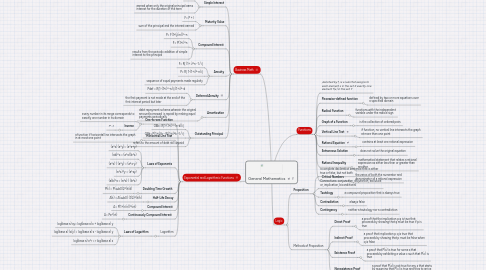
1. Business Math
1.1. Simple Interest
1.1.1. I = Prt
1.1.2. earned when only the original principal earns interest for the duration of the term
1.2. Maturity Value
1.2.1. F= P + I
1.2.2. sum of the principal and the interest earned
1.3. Compound Interest
1.3.1. P= F(1+(j/m))^-n
1.3.2. F= P(1+i)^n
1.3.3. results from the periodic addition of simple interest to the principal
1.4. Annuity
1.4.1. F= R[ (1+ i)^n -1 / i]
1.4.2. P= R[ 1-(1+i)^-n/i]
1.4.3. sequence of equal payments made regularly
1.5. Deferred Annuity
1.5.1. Pdef = R[1-(1+i)^-n/i] (1+i)^-d
1.5.2. the first payment is not made at the end of the first interest period but later
1.6. Amortization
1.6.1. debt repayment scheme wherein the original amount borrowed is repaid by making equal payments periodically
1.7. Outstanding Principal
1.7.1. OBk= R[1-(1+i)^-(n-k)/i]
1.7.2. OBk= P(1+i)^k - R[(1+i)^k -1 / i]
1.7.3. refers to the amount of debt still unpaid
2. Exponential and Logarithmic Functions
2.1. One-to-one Function
2.1.1. every number in its range corresponds to exactly one number in its domain
2.1.2. Inverse
2.1.2.1. f^-1
2.2. Horizontal Line Test
2.2.1. a function if horizontal line intersects the graph in at most one point
2.3. Laws of Exponents
2.3.1. (a^x) (a^y)= (a^x+y)
2.3.2. (ab)^x = (a^x)(b^x)
2.3.3. (a^x) / (a^y) = (a^x-y)
2.3.4. (a^x)^y = (a^xy)
2.3.5. (a/b)^x = (a^x) / (b^x)
2.4. Doubling Time Growth
2.4.1. P(t) = P(sub0)2^(t/d)
2.5. Half-Life Decay
2.5.1. A(t) = A(sub0) (1/2)^(t/h)
2.6. Compound Interest
2.6.1. A= P(1+(r/n))^(nt)
2.7. Continuously Compound Interest
2.7.1. A= Pe^(rt)
2.8. Logarithm
2.8.1. Laws of Logarithm
2.8.1.1. log(base a) xy= log(base a) x + log(base a) y
2.8.1.2. log(base a) (x/y) = log(base a) x - log(base a) y
2.8.1.3. log(base a) x^r = r log(base a) x
3. Functions
3.1. ,denoted by f, is a rule that assigns to each element x in the set X exactly one element f(x) in the set Y
3.2. Piecewise-defined function
3.2.1. defined by two or more equations over a specified domain
3.3. Radical Function
3.3.1. functions with the independent variable under the radical sign
3.4. Graph of a Function
3.4.1. is the collection of ordered pairs
3.5. Vertical Line Test
3.5.1. if function, no vertical line intersects the graph at more than one point
3.6. Rational Equation
3.6.1. contains at least one rational expression
3.7. Extraneous Solution
3.7.1. does not solve the original equation
3.8. Rational Inequality
3.8.1. mathematical statement that relates a rational expression as either less than or greater than another
3.9. Critical Numbers
3.9.1. the zeros of both the numerator and denominator of a rational expression
4. Logic
4.1. Proposition
4.1.1. a complete declarative sentence that is either true or false, but not both
4.1.2. Connectives: conjunction, disjunction, exclusive or, implication, biconditional
4.1.3. Tautology
4.1.3.1. a compound proposition that is always true
4.1.4. Contradiction
4.1.4.1. always false
4.1.5. Contingency
4.1.5.1. neither a tautology nor a contradiction
4.2. Methods of Proposition
4.2.1. Direct Proof
4.2.1.1. a proof that the implication p q is true that proceeds by showing that q must be true if p is true
4.2.2. Indirect Proof
4.2.2.1. a proof that implication p q is true that proceeds by showing that p must be false when q is false
4.2.3. Existence Proof
4.2.3.1. a proof that P(x) is true for some x that proceeds by exhibiting a value c such that P(c) is true
4.2.4. Nonexistence Proof
4.2.4.1. a proof that P(x) is not true for any x that starts by assuming that P(c) is true and tries to arrive at contradiction
